|
|
|
Sort Order |
|
|
|
Items / Page
|
|
|
|
|
|
|
| Srl | Item |
| 1 |
ID:
036288


|
|
|
|
|
| Publication |
Oxford, Oxford University Press., 1986.
|
| Description |
xxxii, 611p.hbk
|
| Series |
SIPRI Yearbook 1986
|
| Standard Number |
0198291000
|
|
|
|
|
|
|
|
|
|
|
|
Copies: C:1/I:0,R:0,Q:0
Circulation
| Accession# | Call# | Current Location | Status | Policy | Location |
| 026441 | 327.17405/SIP 026441 | Main | On Shelf | General | |
|
|
|
|
| 2 |
ID:
167675
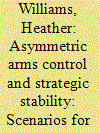

|
|
|
|
|
| Summary/Abstract |
Can arms control incorporate emerging technology? Other articles in this special issue identify potential risks emerging technologies pose to stability and how they are intertwined with international politics. Is there a future for multilateral strategic arms control? This article looks ahead to explore how arms control might reduce those risks but in order to do so we must update concepts of both arms control and strategic stability. Building on Thomas Schelling and Morton Halperin’s seminal study into the relationship between strategic stability and arms control, this article offers an original framework – asymmetric arms control – for incorporating new technologies, which is then used to identify six scenarios for arms control of hypersonic glide vehicles (HGVs). It concludes that arms control can potentially reduce the risks to strategic stability associated with emerging technologies by incorporating dynamism into arms control design. Ultimately, asymmetric arms control can best contribute to strategic stability by crossing domains and reflecting the cross-domain nature of international conflict, and the framework has potential application to emerging technologies beyond HGVs.
|
|
|
|
|
|
|
|
|
|
|
|
|
|
|
|
| 3 |
ID:
131619


|
|
|
|
|
| Publication |
2014.
|
| Summary/Abstract |
The first multinational conference dedicated exclusively to robotic warfare took place May 13-16 at the UN Office at Geneva as governments around the world confront the emerging technologies that policymakers call "lethal autonomous weapons systems" and headline writers have dubbed "killer robots." The three-day meeting featured diplomats, scholars, and activists debating the implications of new weapons that could automatically target and kill people without human control. Although few such weapons exist now, revolutionary developments in sensors and robotics have stoked fears in some quarters that these weapons systems could make warfare less risky for the attacker and therefore more indiscriminate, but raised hopes in others that they might reduce civilian casualties.
|
|
|
|
|
|
|
|
|
|
|
|
|
|
|
|
| 4 |
ID:
132479
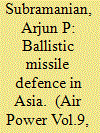

|
|
|
|
|
| Publication |
2014.
|
| Summary/Abstract |
The one continent where ballistic missiles have proliferated tremendously is Asia. There are some important factors that have been, and are, contributing to such a trend in the region. Firstly, the demand for the ballistic missile as it is a relatively cheap weapon to develop and deploy compared to a large and sophisticated air force. Also, this weapon is hard to counter even by the most technologically advanced countries. Secondly, the existing geo- political make-up where confrontation is between states that are at opposite poles of the power spectrum, where the weaker side finds such weapons most suitable to counter a technologically superior adversary. Thirdly, the ready availability of the technology and vital components through both legal and clandestine means. These factors have enabled states like North
Korea with a less than meagre technology base to adapt the technology, of course, with tremendous assistance, to develop ballistic missile capability. With the rapid proliferation of these weapons in Asia, countries facing this threat have been looking for ways to counter it. Most have turned to some level of Ballistic Missile Defence (BMD). This paper attempts to study the ballistic missile threat and the missile defence efforts of the US and its allies in East Asia, China, Israel and India.
|
|
|
|
|
|
|
|
|
|
|
|
|
|
|
|
| 5 |
ID:
131417
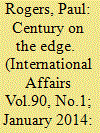

|
|
|
|
|
| Publication |
2014.
|
| Summary/Abstract |
The article argues that the century from 1945 is likely to prove seminal in terms of human progress. It marks the period when the human community has to come to terms with its capacity for self-destruction through the invention of weapons of mass destruction and its ability to exceed the homeostatic capabilities of the global ecosystem in an era of deep socio-economic divisions. Two-thirds of the way through this century the progress has been mixed. Nuclear war has been avoided more by luck than by wisdom, there remain risks of nuclear proliferation and it is not evident that humankind has acquired the ability to deal with the destructive potential of bio-, nano- and other emerging technologies. Recognition of the extent of anthropogenic impacts on ecosystem stability is evident, but not at the level necessary for the radical responses required. Even so, there are signs of progress and potential for change, suggesting that the final one-third of the century will be singularly important in ensuring long-term emancipation and environmental sustainability.
|
|
|
|
|
|
|
|
|
|
|
|
|
|
|
|
| 6 |
ID:
185168
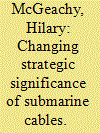

|
|
|
|
|
| Summary/Abstract |
The strategic significance accorded to submarine cables has never been a static concept, but it has been homogenous: a focus on protecting cables from external threats. This article argues that because submarine cables have long had strategic value, they provide a means to examine the emerging concept of strategic technology competition between the United States and China. To do so, this article examines major changes to the submarine cable sector since 2015, including the success of Chinese company Huawei Marine, and US and other western government interventions in several cable projects. It characterises the strategic considerations exhibited by submarine cable activity in that period – influence building in third countries, a changing perception among the US and its partners of threat and protection priorities, and closer attention to cable security and surveillance considerations – and compares them with the traditional strategic values attached to submarine cables. It concludes strategic concerns about undersea cables includes a new concept: the construction and installation of cables as a strategic threat, and which adds complexity to a sector in which it is difficult to project influence. This article seeks to make a contribution to scholarship on strategic competition in emerging technologies.
|
|
|
|
|
|
|
|
|
|
|
|
|
|
|
|
| 7 |
ID:
178329


|
|
|
|
|
| Summary/Abstract |
A “connected battlespace” (CB) aims to leverage emerging technologies, such as low Earth orbit satellites, internet of things devices, cloud computing, and artificial intelligence, in order to collect, process, and disseminate large quantities of data in real time, thereby providing decision-makers with the ability to respond to threats faster and with more precision. Despite its promise, as a concept, a CB is still misunderstood, underdeveloped, and understudied. In an effort to fill this gap, this policy brief describes several key findings derived from an expert stakeholder workshop that the authors convened in July 2020. Workshop participants probed several questions about the development of Canada’s CB infrastructure, touching on a number of themes, including alliance partnerships, emerging technology, procurement, national security, and defence strategy. Our article synthesizes and analyzes key discussions held during this workshop.
|
|
|
|
|
|
|
|
|
|
|
|
|
|
|
|
| 8 |
ID:
177041
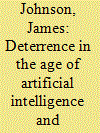

|
|
|
|
|
| Summary/Abstract |
How might nuclear deterrence be affected by the proliferation of artificial intelligence (AI) and autonomous systems? How might the introduction of intelligent machines affect human-to-human (and human-to-machine) deterrence? Are existing theories of deterrence still applicable in the age of AI and autonomy? The article builds on the rich body of work on nuclear deterrence theory and practice and highlights some of the variegated and contradictory – especially human cognitive psychological – effects of AI and autonomy for nuclear deterrence. It argues that existing theories of deterrence are not applicable in the age of AI and autonomy and introducing intelligent machines into the nuclear enterprise will affect nuclear deterrence in unexpected ways with fundamentally destabilising outcomes. The article speaks to a growing consensus calling for conceptual innovation and novel approaches to nuclear deterrence, building on nascent post-classical deterrence theorising that considers the implications of introducing non-human agents into human strategic interactions.
|
|
|
|
|
|
|
|
|
|
|
|
|
|
|
|
| 9 |
ID:
190851
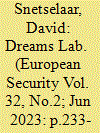

|
|
|
|
|
| Summary/Abstract |
Amid concerns over the rivalry between Washington and Beijing, the discourse and practice of knowledge security have become prevalent in Europe. This is especially true with regard to Sino-Western research collaborations on emerging technologies. Despite the scientific and economic benefits, these collaborations are increasingly perceived as a potential threat in the context of broader concerns with so-called hybrid threats. Knowledge security has emerged as a key term to identify and mitigate the risk of espionage, unwanted knowledge transfers, censorship, and the misuse of dual-use technology. To understand knowledge security and its implications, the article offers a qualitative, in-depth case study of Dreams Lab in the Netherlands: an AI research project run by the University of Amsterdam and the Free University of Amsterdam and funded by the Chinese company Huawei. Li’s practices of assemblage are used as an analytical framework to answer the question: how and why a diverse group of actors were brought together to respond to Dreams Lab and govern scientific knowledge on emerging technologies? By analysing the discourse and practice of knowledge security, the article offers crucial insights into how the great power rivalry is shaping scientific research and the international exchange of knowledge and technology.
|
|
|
|
|
|
|
|
|
|
|
|
|
|
|
|
| 10 |
ID:
167676
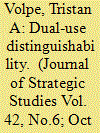

|
|
|
|
|
| Summary/Abstract |
Additive manufacturing is being adopted by nuclear programmes to improve production capabilities, yet its impact on strategic stability remains unclear. This article uses the security dilemma to assess incentives for arms racing as the emerging technology becomes integrated into nuclear supply chains. Innovations sow the ground for competition by making it easier to produce weapons and harder to distinguish civil from military motives. But additive manufacturing could still mature into an asset by revealing greater information about nuclear aspirants. Beyond the nuclear realm, the article refines offense-defence theory to explain how changes in non-military technology shape the practice of deception.
|
|
|
|
|
|
|
|
|
|
|
|
|
|
|
|
| 11 |
ID:
179277
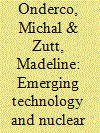

|
|
|
|
|
| Summary/Abstract |
What is the impact of emerging technologies on nuclear security and disarmament? Current rapid technological advances are taking place against the backdrop of increased investments in modernizing nuclear arsenals, rising tensions among great powers, and increased pressure on nuclear arms control agreements. Yet, the anticipated net effect of these emerging technologies on the nuclear landscape remains ambiguous. Through a survey with 85 experts and a series of elite interviews with 14 decision-makers, this article contends that while emerging technologies destabilize nuclear deterrence by increasing nuclear risk, they can also create fresh opportunities for nuclear disarmament. Given that new technologies are changing the nature of nuclear threats, this article also argues that we need to change the way we think about arms control if we want to respond effectively to the threats posed by emerging technologies.
|
|
|
|
|
|
|
|
|
|
|
|
|
|
|
|
| 12 |
ID:
178737
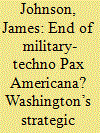

|
|
|
|
|
| Summary/Abstract |
This article uses the international relations (IR) ‘polarity’ concept as a lens to view the shifting great power dynamics in artificial intelligence (AI) and related enabling technologies. The article describes how and why great power competition is mounting in within several interrelated dual-use technological fields; why these innovations are considered by Washington to be strategically vital, and how (and to what end) the United States is responding to the perceived challenge posed by China to its technological hegemony. The following questions addressed in this paper fill a gap in the existing literature: Will the increasingly competitive U.S.-China relationship dominate world politics creating a new bipolar world order, as opposed to a multipolar one? Why does the U.S. view China’s progress in dual-use AI as a threat to its first-mover advantage? How might the U.S. respond to this perceived threat?
|
|
|
|
|
|
|
|
|
|
|
|
|
|
|
|
| 13 |
ID:
186540
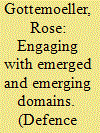

|
|
|
|
|
| Summary/Abstract |
Cyber, space, and emerging technologies have transformed the strategic environment. Since the last publication of the NATO Strategic Concept, the Alliance has responded to this changing environment by addressing emerged and emerging threats at differential rates of operational and policy planning. Now, NATO must seek to holistically integrate these domains into the forthcoming strategic concept to increase the resilience and effectiveness of the Alliance. An adaptable and resilient Alliance that responds to the challenge of cyber, space, and emerging technologies will be best realized through three primary avenues. First, reaching preemptive consensus on actions short-of-force and consensus on space and cyber actions that trigger Article 5 will enhance collective defense and crisis management. Second, communication of capabilities and resolve will promote deterrence and enhance cooperative security among member states. Finally, cooperation with industry partners and among Allies to maintain a cutting technological edge is essential for NATO’s collective defense against emerging threats and enhances cooperative security through a common strategic culture of innovation. It is essential that NATO prevents cyber, space, and emerging technologies from being understood and actioned in isolation, and instead thoughtfully integrates technologies into the Alliances’ key tasks.
|
|
|
|
|
|
|
|
|
|
|
|
|
|
|
|
| 14 |
ID:
190703
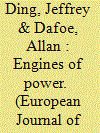

|
|
|
|
|
| Summary/Abstract |
Major theories of military innovation focus on relatively narrow technological developments, such as nuclear weapons or aircraft carriers. Arguably the most profound military implications of technological change, however, come from more fundamental advances arising from ‘general-purpose technologies’ (GPTs), such as the steam engine, electricity, and the computer. Building from scholarship on GPTs and economic growth, we argue that the effects of GPTs on military effectiveness are broad, delayed, and shaped by indirect productivity spillovers. We label this impact pathway a ‘general-purpose military transformation’ (GMT). Contrary to studies that predict GPTs will rapidly diffuse to militaries around the world and narrow gaps in capabilities, we show that GMTs can reinforce existing balances if leading militaries have stronger linkages to a robust industrial base in the GPT than challengers. Evidence from electricity's impact on military affairs, covering the late nineteenth and early twentieth centuries, supports our propositions about GMTs. To probe the explanatory value of our theory and account for alternative interpretations, we compare findings from the electricity case to the military impacts of submarine technology, a non-GPT that emerged in the same period. Finally, we apply our findings to contemporary debates about artificial intelligence, which could plausibly cause a profound GMT.
|
|
|
|
|
|
|
|
|
|
|
|
|
|
|
|
| 15 |
ID:
131728
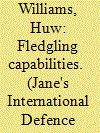

|
|
|
|
|
| Publication |
2014.
|
| Summary/Abstract |
Micro and nano UAVs are emerging as the latest link in the unmanned chain and are finding their niche on the modern battlefield. However how they will develop in future remains to be seen.
|
|
|
|
|
|
|
|
|
|
|
|
|
|
|
|
| 16 |
ID:
188904


|
|
|
|
|
| Summary/Abstract |
The Synthetic Environment (SE) takes the power of computing, digital processing, artificial intelligence, extended reality technology, and other advancements borrowed from the gaming industry to create a computer simulation with near-perfect levels of realism. Designed to enable connectivity across all domains and platforms, SE has the potential to dramatically improve military training, force development, situational awareness, and communications. Our article provides a technical overview of SE and offers a high-level analysis of its use in Canada, the US, UK, and Australia. Informed by dozens of interviews and a roundtable workshop held with experts from academia, industry, and government, this article relates SE to Canada’s future defence policy. We argue that leveraging SE effectively will require that Canada commit to a long-term SE program, promote new government-industry partnerships, encourage top-down leadership from both civilian and military officials, and consolidate domestic skillsets and industry knowhow to maintain and retain Canadian sovereignty.
|
|
|
|
|
|
|
|
|
|
|
|
|
|
|
|
| 17 |
ID:
188914


|
|
|
|
|
| Summary/Abstract |
The Synthetic Environment (SE) takes the power of computing, digital processing, artificial intelligence, extended reality technology, and other advancements borrowed from the gaming industry to create a computer simulation with near-perfect levels of realism. Designed to enable connectivity across all domains and platforms, SE has the potential to dramatically improve military training, force development, situational awareness, and communications. Our article provides a technical overview of SE and offers a high-level analysis of its use in Canada, the US, UK, and Australia. Informed by dozens of interviews and a roundtable workshop held with experts from academia, industry, and government, this article relates SE to Canada’s future defence policy. We argue that leveraging SE effectively will require that Canada commit to a long-term SE program, promote new government-industry partnerships, encourage top-down leadership from both civilian and military officials, and consolidate domestic skillsets and industry knowhow to maintain and retain Canadian sovereignty.
|
|
|
|
|
|
|
|
|
|
|
|
|
|
|
|
| 18 |
ID:
114842
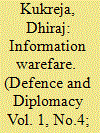

|
|
|
| 19 |
ID:
165213
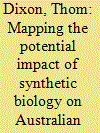

|
|
|
|
|
| Summary/Abstract |
Synthetic biology is an emerging technology that will impact on the future security and prosperity of Australia. As a discrete policy area synthetic biology has not been explored in relation to Australian foreign policy. To begin this process an understanding of Australia’s genetic endowment, Australia’s agricultural endowment and those security concerns novel to synthetic biology need to be developed. The convergence of the biological sciences and the information sciences is creating novel security concerns that impact on Australian sovereignty, both mainland and the Antarctic Territories, plant and animal health, and defence medical infrastructure. These concerns cross many traditional disciplinary and policy boundaries, an awareness of this is required and a nascent national practitioner community can develop this further. Drawing from work conducted by the US and UK synthetic biology practitioner communities, this article lays out the unique touch points synthetic biology has on Australian foreign policy.
|
|
|
|
|
|
|
|
|
|
|
|
|
|
|
|
| 20 |
ID:
190870
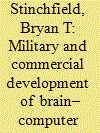

|
|
|
|
|
| Summary/Abstract |
Brain-computer interfaces (BCIs) are an emerging dual-use technology that will affect international security in ways similar to other dual-use technologies such as artificial intelligence, autonomous weapons, and cyber tools and tactics. In this paper, I use open sources and network analyses to reveal the structure of the BCI research and development industry, which indicates that BCIs will soon be operational, and the technology will diffuse across many sectors and regions. As a result, I argue that the unique qualities of BCIs will provide incentives to engage in conflict and disrupt international security; therefore, militaries in liberal democracies should strive to achieve and maintain BCI technological superiority over authoritarian regimes and violent non-state actors.
|
|
|
|
|
|
|
|
|
|
|
|
|
|
|
|
|
|
|
|
|